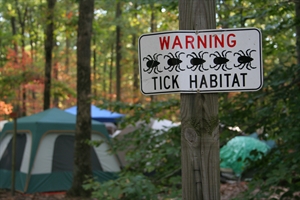Finding a tick on your body after a day in the great outdoors is unpleasant enough – but did you know they carry some really unpleasant diseases? So it’s really important to practise tick avoidance at home and while travelling.
What is a tick?
Ticks are small arachnids (spider relatives) that are found all over the world. They feed on blood by attaching themselves to exposed skin. Like other blood-feeders, ticks can transfer disease-causing organisms to the host (i.e. you).
What diseases do ticks carry?
The list of diseases ticks carry includes:
- babesiosis
- tick-borne encephalitis
- Heartland virus
- Lyme disease
- rickettsial diseases such as Rocky Mountain spotted fever
- Powassan virus disease
- Colorado tick fever.
There is a vaccine that provides protection from tick-borne encephalitis (TBE), and it is offered to travellers going to Europe and Asia. You are not at risk from TBE in Canada. However, if you get bitten by a tick in Canada, you risk exposure to:
- Colorado tick fever viruses
- Lyme disease bacteria
- Powassan virus disease (very rare)
- rickettsial diseases.
The links will take you to the Government of Canada’s information on each disease. The risks from tick bites vary by region, and by time of year so we recommend getting up-to-date advice from your healthcare provider so you can assess the risk accurately. But in any case, you’ll want to avoid tick bites both at home and while travelling.
Am I at risk from tick-borne diseases?
Anyone who gets bitten by a tick is at risk from tick-borne diseases. You are most likely to get a tick bite if you work or do activities in forested, shrubby or grassy areas. So forestry and agricultural workers are at increased risk of getting bitten by a tick. And so are hikers, dog walkers, cyclists and campers. Freshwater fishing is another activity with a risk of tick bites.
What does a tick bite look like?
A feeding tick resembles a full stop with legs stuck somewhere on your skin. Some ticks are very small (the size of a poppy seed) and their bites are small too. Others are larger and more obvious. Tick bites may be painless so you may not even know you have been bitten.
How can I avoid tick bites?
Wearing light-coloured clothing will help you to spot ticks on your clothes. You should also wear long sleeves and pants. Closed-toe shoes offer the best protection, and you can pull socks over your pant legs to keep ticks and other insects at bay. An insect repellent containing DEET will also help you avoid tick bites.
Check your body for ticks and other parasites every day after doing a high-risk activity.
What should I do if I find a tick on my body?
It’s best to remove a tick as soon as you find it. Use clean tweezers to catch the tick’s head close to your skin and pull it straight out. You can wash the site with soap and water, or with hand sanitizer. You may need to go in again with the tweezers if the tick’s mouthparts break off – but if you can’t get them out, leave them in place and the skin will push them out as it heals. Save the tick in a small zip-lock bag, and if you fall ill later you can bring it to your medical appointment to help with assessment.
Where can I get travel vaccinations in Calgary?
If you need an appointment at a travel clinic, turn to Canadian Travel Clinics. It is quick and easy to book online.

